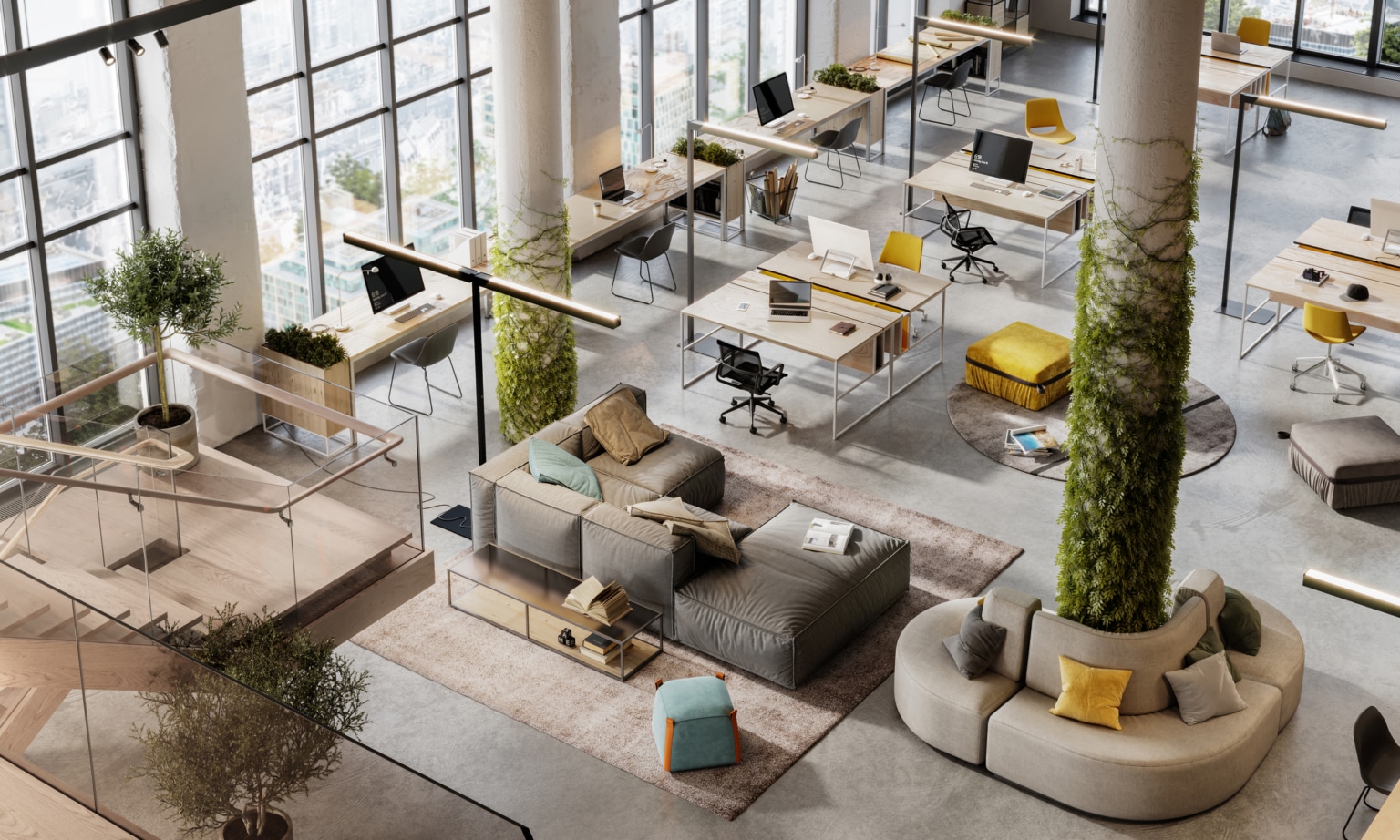Language is constantly evolving and adding new words and terms to our lives. This is especially true in the work environment, which often features new terms or adaptations of existing words to new meanings.
One term that has appeared in recent decades (and has become more used recently) is ‘hot desking’. But what does the term actually mean? Is it something that offers workers (and businesses) advantages or disadvantages? And if you are told to hot desk, how can you make it work for you in an office environment?
What is Hot Desking?
Some people believe (though this is unverified) that the term hot desking came from the naval practise of ‘hot racking’ where more than one sailor would share bunk space over different shifts. The term – and the practice – now known as hot desking, first appeared in the early 1990s.
As with its claimed origin, hot desking is about sharing a space with your co-workers rather than having assigned desks. This could be an actual desk or a cubicle and can apply to either sharing that space if you are on a flexible working pattern or simply claiming a space when you arrive at your work areas.
Occasionally, there is a crossover – and some confusion – with the term ‘hoteling’, but it is important to note the main difference between the two terms. Hot desking refers to claiming whatever space is available when you arrive at your workspace. Hoteling refers to ‘booking’ desk space before you arrive using a programme such as DeskFlex.
How Does Hot Desking Work?

Hot desking primarily happens in two types of office environment; private (as in the space, all belongs to the same company) and shared (where several businesses or freelancers utilise an office space). Put, you arrive at your office, choose whatever space is available, and set up your laptop or device ready to start work.
In a private office, people may come to informal agreements on how to divide their work environment. This may be based on teams working on collaborative projects agreeing on how desk space is allocated. While personal space is not normally an aspect of hot-desking, informal agreements may allow for this.
Shared office space differs slightly as it is not just about the actual desk space. Shared offices usually also provide meeting rooms or conference rooms, but these have to be booked in advance for meetings.
Shared spaces are most often used by freelancers or small companies, including startups, who may not have a private space budget. Being a subscriber to shared space and tools may suit them.
The Pros and Cons of Hot Desking
As with anything, there are both pros and cons to hot desking. If you are considering moving away from the assigned desk model and having your staff become hot deskers, it helps to have an idea of what advantages and disadvantages such a move will entail.

Pros:
- Cost.
The most obvious advantage of hot desking is that it offers a cost-effective solution. It may be that you have staff on flexible working patterns. Or, in an industry such as real estate, staff may spend more time out of the office than in it. And with the COVID pandemic, many companies have moved staff to remote working with limited office time, so are downsizing physical locations. Smaller or fewer physical locations means less expense.
- Flexibility & mobility.
Many companies have been letting office workers move toward flexible working for years. This is mainly to allow them to achieve a better work-life balance or suit the companies themselves’ changing needs. Businesses with low desk utilisation rates found that there was no need for an assigned space as much face-to-face work outside the office.
- Increased collaboration.
While working on a particular joint project, the ‘free for all’ philosophy of hot desking may not be ideal. Otherwise, hot desking can promote better collaboration. By moving workers out of the traditional silos of assigned spaces, creativity and productivity can be boosted due to the increased sharing of new ideas.
- Better communications.
In a traditional setup, communication can, to an extent, stagnate. Other than your immediate neighbours, you may find that communication with co-workers happens via email or a messaging app or service, if at all. With the changing office set up of hot desking, staff are more open to the idea of real-time, face to face communications. That can again boost creativity and productivity.

Cons:
- Technology.
Depending on your business type and your teams’ makeup, switching to hot desking may present challenges for your IT department. Different staff may have different needs when it comes to the systems and software they use. Unless there is a common setup on desktop PCs, many people use laptops when hot desking. Look at what you and your staff need.
- Work types & styles.
Some types of work do not lend themselves well to hot desking. For example, team members working on programming and designing an app may want a particular computer setup and work within their existing close-knit team. Such workers, too, tend to fill any personal space with non-work related items and work notes, post-it notes, memos, etc.
- Competition for spaces.
Whether real or perceived, some spaces may be viewed as being ‘better than others. They may be out of direct sunlight, and they may be next to a water cooler, etc. But this could lead to some frustration or upheaval if people are competing for spaces. If this does happen, you could bring in an in-house hoteling system where spaces can be reserved in advance.
- Distractions.
While in some cases, hot desking can boost productivity, the opposite can also be true. If you concentrate on a specific project while your neighbours are having a heated discussion or brainstorming session, this can be distracting to the lone worker. If co-workers need to have such discussions, ensure a meeting room space can be utilised.
How to manage a hot desking workplace

Any change to your organisation’s structure or processes comes with unique challenges. It is not enough to switch to hot desking without taking potential issues into account and having strategies ready to deal with them. Having a clear set of ‘rules’ in place benefits both you as a manager and your staff.
1. Manage all changes.
You may be implementing hot-desking as a standalone policy. Or it may be part of a wider change to your company’s culture that includes other things such as flexible working or remote working. But you have to show leadership throughout the change, from clear explanations of what the change means and why you are doing it to monitoring and supervising the process.
2. Try different tactics.
Depending on your and your staff’s needs, you may want to consider implementing different tactics as part of the change. A ‘free for all may not work for your business model, so consider tactics such as hoteling (the ability to reserve a space in advance) or zoning (where certain areas of the office space are allocated to particular teams or projects).
3. Adapt to technology.
Some staff may complain that the new system separates them from work colleagues they regularly collaborate with. But it is fairly simple to adapt the many video conferencing or other communication tools to being used within the office rather than outside it. Make sure you listen to the needs of your staff and see what technological solutions are available.
4. Cleanliness.
Some people thrive in chaos, and when they have their own personal desk, they may not always have it clean and tidy. But when there is a shift to hot desking, you need to ensure that policies in place cover how co-working spaces should be left at the end of the working day. Providing lockers for storing any personal items can also help with this.
5. Transparency.
People can be afraid of change and hesitant to embrace it. It can help greatly if you clearly communicate your plans and your reasons for them. Holding meetings before any change can be far more beneficial than addressing complaints after it. Make your staff feel part of the process rather than just the subjects of it.
How to Know if Hot Desking Isn’t Right for You

Hot desking is not a one size fits all strategy. It may not suit your particular industry, your company culture, or even your employees’ work style. If your business deals with sensitive and confidential information, for instance, the idea of hot desking may not appeal to you.
There are regular collaboration and discussion between specific or specialist teams; too, the concept of changing desks every day may be disruptive to their workflow. Hot desking may also not work if you have high staff turnover and frequent trainees in place.
But it is worth remembering that hot desking does not have to be exclusively that model. You can adopt a hybrid model where some staff have their own personal space and rotate as hot deskers. Auditing your business needs and listening to staff concerns can help identify which, if any, new model will work for you.
The Takeaway
In a time when companies face many challenges, organisations are looking to streamline and seek new solutions. But changing to a hot-desking model is not something to be rushed into with only the idea of saving money at its core. It needs careful examination and consideration.
If it does suit your organisation, then the implementation should be clearly explained to staff, and any concerns listened to. Constructing a well thought out systemic change can prove the benefits of hot desking. Rushing into a new way of working, though, may have detrimental effects for many months to come.
Originally published Mar 24, 2021, updated Apr 23, 2021


